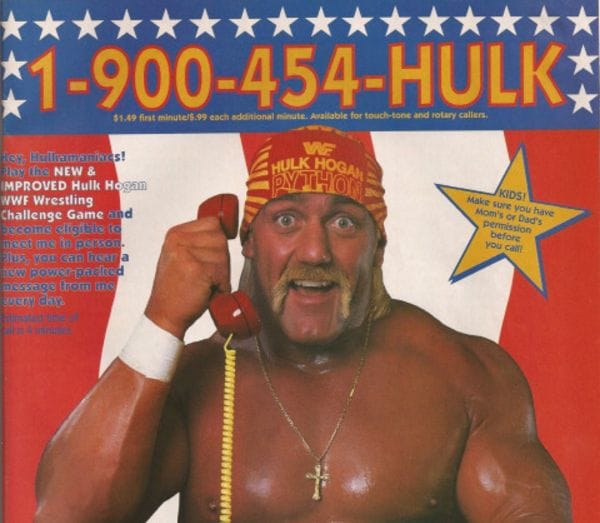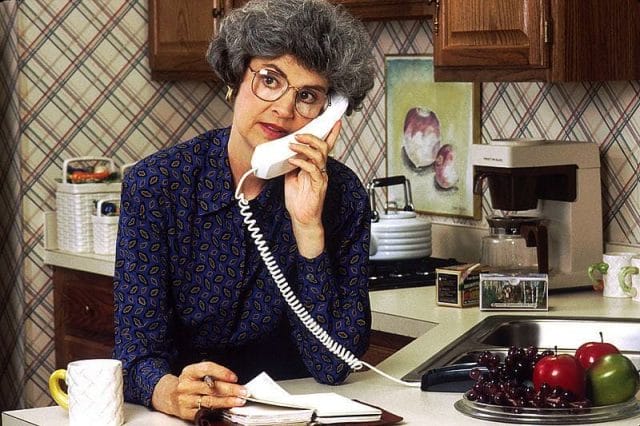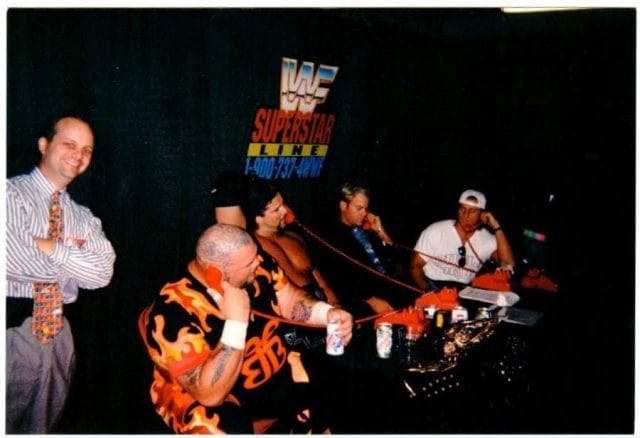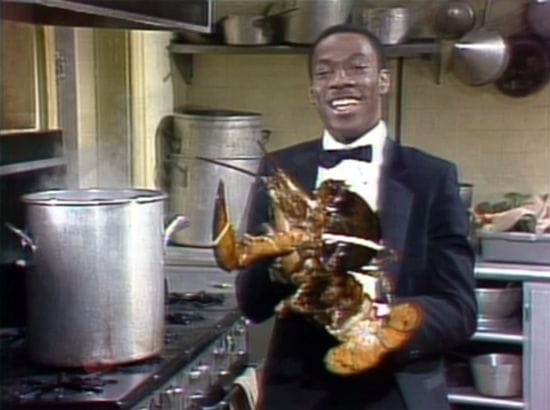
On the 16th episode of the 7th season of Saturday Night Live, Eddie Murphy threatened to kill a lobster.
“You want to save Larry the Lobster,” Murphy told the viewers, “dial 1-900-720-1808. If you want to kill him, dial 1-900-720-1909. Now, unless you call in to save him, we’re going to boil Larry’s little butt right here on national television…The phone company is going to charge you 50 cents, but isn’t it worth 50 cents to save Larry’s life? Or look at it this way: Isn’t it worth half a buck to see us boil Larry on TV?”
At least four times during that April 1982 episode, Murphy petitioned the audience to call in, even telling Larry the Lobster’s life story. By the end of the show, almost 500,000 people had placed calls. The episode caused such an unexpected spike in calls that AT&T, the phone carrier, later created a team to keep track of man-made events that could disrupt its system.
AT&T billed more than $200,000 that night, marking a glorious moment for the young 900 number business. In the late 1980s, dialing a number with the 900 prefix on your landline phone became a way to gain access to a web of information on any number of subjects before the Internet as we know it existed.
While expensive and technologically limited, for a few boom years, 900 numbers that charged by the minute filled a gap for people who required daily updates on nearly anything. From the score in the fifth inning of a Yankees game to surfing conditions in southern California to the latest news from DJ Jazzy Jeff & the Fresh Prince, 900 numbers were an information revelation before they finally died in 2012. Larry the Lobster was just a blip on what would soon become a billion-dollar industry.
But would Larry live or die?
900 Numbers — The Early Years
The Larry the Lobster sketch was actually a spoof on one of the earliest uses of a 900 number, which first came to public notice as a polling device in 1980 when ABC’s Nightline asked viewers who they thought won the Ronald Reagan-Jimmy Carter presidential debate. For 50 cents, viewers could call one of two numbers, and AT&T recorded the number of calls to each to determine who the audience felt was the winner.
Information services, where people could call a 900 number and hear a recorded or live message, were also coming into their own in the early- and mid-1980s. (Other prefixes, notably 976, had already attracted millions of calls to regional services.) In 1982, more than a million people called what eventually came to be known as Dial-A-Shuttle at 1-900-909-NASA to listen to live conversations between ground control and the astronauts. That same year, during the infamous Tylenol tampering scare, Johnson & Johnson used a 900 number to release updates to the public.
During these early years, when carriers took in almost all the revenue from 900 number calls, the technology was fairly basic; there was no interactivity, no using your touchtone phone to select an option. Still, in 1981, the first full year of service, AT&T recorded 10.9 million calls. That number would soon look miniscule.
In 1987, AT&T started a national program that allowed 900 number information providers—people who provided the audio content—the chance to earn money from their numbers. Similar to the way anyone can now start their own e-commerce website, AT&T opened up the 900 program to any entrepreneur who had an idea, and set a price of up to $2.00 for the first minute of a call (and more for additional minutes). An entirely new information economy opened up overnight, and the first 900 number entrepreneurs struck gold.

In the early 90s, people with cool, blocky phones could pay by the minute to access a proto-Internet. Photo by Bill Branson
One of those pioneers was a man named Bob Bentz, author of the book Opportunity Is Calling: How to Start Your Own Successful 900 Number. In 1987, Bentz was working in TV advertising at a CBS affiliate in Hartford, Connecticut. From midnight to 6am, when it aired low-grade reruns, the station would sell cheap spots to the producers of adult-themed 900 numbers. “We would raise their rates every quarter,” says Bentz. “When they came to renew, they would complain, and then they would say yes. I knew there had to be some money in this.”
Prior to 1987, there were only 44 numbers with the 900 prefix available while AT&T beta-tested the technology. Bentz says there were rumors that the people who got those first numbers, which they mainly used for adult chat lines, became wealthy practically overnight.
Bruce Kushnick, a telecom strategist who helped Sprint start its own 900 service in 1989, says that during those early days it was a free-for-all. He remembers being in a meeting with 25 or so of the first national pay-per-call developers when someone asked how many people in the room were millionaires. Just about everyone raised a hand.
Service Provider to the Stars
In contrast to the early web, where content was free, the 900 number business began with a business model—charge for content by the minute. By 1989, AT&T, MCI, Sprint, and a smaller carrier called Telesphere had opened up 900 numbers to the masses, so anyone with a bit of start-up cash could start a line. Bentz founded a company called Advanced Telecom Services to assist 900 number entrepreneurs, and soon he’d helped launch phone lines that look like a preview of today’s most popular websites.
ATS’s first big success story was a crossword puzzle line with the New York Daily News. If you were into the daily crossword, but got stuck on 19-across, you could call the hotline and get the answer.
ATS also created a large network of sports lines with an emphasis on college football recruiting. There was no Internet to speak of, so if you were a Florida Gators alum living in Salt Lake City, and you wanted to hear interviews with coaches and the latest recruiting news, you could call the Gatorbait Hotline. One Gators fanatic in 1992 said he spent $400 monthly on calls.
Eventually ATS was running hotlines for 65 Division I college football teams, 20 NFL teams, and a handful of MLB and NBA teams. The numbers were run by local sports reporters who supplemented their income by contributing to the lines. “It didn’t take long for them to realize that they were making more from the supplement,” says Bentz.
Another big program for ATS was personals. “You gotta think pre-Match.com here,” says Bentz. People looking for a date would call a 900 number, listen to a voice recording of someone whose description they read in the newspaper, and then leave them a message. If the receiving person liked what they heard, they might send a message back. Basically, a much slower version of online dating. Personals were a huge moneymaker for newspapers then, so ATS teamed with them to combine the hotlines with the print ads, forming partnerships with more than 200 newspapers.
ATS ran hotlines for celebrities like Michael J. Fox, the Backstreet Boys, Prince, Pink Floyd, and Michael Bolton, each of whom received a cut of the revenue. Wrestling hotlines were also big business, and ATS partnered with Hulk Hogan, “Macho Man” Randy Savage, and Miss Elizabeth, among others. Bentz or one of his colleagues would go to all the big pay-per-view events, like WrestleMania, and interview the stars. “When the wrestlers came out of the ring,” says Bentz, “their first stop was to be interviewed for the 900 number hotline.”

An old photo of Bentz with wrestling stars on 1-900 numbers. Photo credit: Bob Bentz
In addition to sports, personals, and chat lines, 900 numbers were also useful for information providers who could fill odd niches. Some numbers were kind of like subreddits of the late 1980s and early 1990s, where people with a common interest could get updates. ATS had a guitar tuning hotline (“Dial an A”), a mortgage calculator hotline, an insomnia hotline that played music to help you fall asleep (“The only problem was the bill the next morning,” says Bentz), and a hotline for drum and bugle corps competitors to learn their results.
In 1993, there were more than 10,000 900 numbers in operation. You could call a number to play interactive Wheel of Fortune, to get farm commodity prices or surfing conditions, to get advice from a lawyer or an estimate on your used car, to order a soap opera magazine, to hear a religious rap song, or to meet a single man in Alaska.You could dial a 900 number to help victims of Hurricane Hugo, to get coupons, to record a music audition, to vote for Miss America, or to get Microsoft technical support. There were cartoon hotlines, tax help hotlines, joke hotlines, insurance hotlines, and even horror hotlines. For $60, you could call a 900 number and listen to a three-hour live broadcast of a Penn State football game. There was even a $25 hotline you could call to get information on starting a hotline!
The 900 industry offered much of what the Internet later would. But instead of offering it for free alongside poorly-performing ads, 900 numbers supported content creators. A typical call cost $1.99 for the first minute, and 99 cents for each additional minute. The average call length was three and a half minutes. That brought the total to about $5 per call, split among the carriers, the service bureau (like ATS), and the owner of the number. In 1989, the DJ Jazzy Jeff & The Fresh Prince rap hotline earned the stars at least six figures of income.
The business was so booming that two books on making money off 900 numbers—including Bentz’s—sold nearly 50,000 copies between them. Industry billing grew from an estimated $60 million in 1988 to almost a billion dollars in 1991.
From Under-Regulation to Over-Regulation
There was a renegade aspect to the 900 number industry, and this made its fall nearly as quick as its rise.
“In those days it was the wild west. There were literally no rules or regulations,” says Kris Kupzcyk, a pioneer of the 900 number business. “People were doing whatever they wanted.” As a young single mother, Kupzcyk put two kids through college on her income from 900 numbers.
At least some of Kupzcyk’s work involved adult chat lines, which is what most people who lived through the era associate with 900 numbers. Americans saw endless late-night commercials filled with fantasy girls lying awkwardly in silk lingerie while holding touchtone phones. In 1988, just a year after the 900 rise really started, Congress passed a lawthat banned so called “dial-a-porn.” But a year later, the Supreme Court overturned the ban.
Moral judgment aside, there were real problems with fraud in the early years of 900 numbers. Scammers inserted long delays into messages to ramp up charges, peddled worthless generic information, made messages purposefully difficult to hear, and charged excessive, unadvertised fees. In one case, a company advertised a 900 number for driver jobs in 60 newspapers at $20 per call, but didn’t reveal that there were only three positions available. Perhaps the most stunning scandal was a TV ad for a Santa Claus hotline that urged children to hold their phones up to the screen. When they did, a programmed tone automatically dialed a 900 number. The phone bill was a hell of a present for mommy and daddy.
The most serious cases involved children. Local and national media reported on a 17-year-old’s $10,500 phone bill for using chatlines, a boy with a disability’s $8,000 bill for a phone quiz, and a girl who called teen idol Corey Haim’s hotline 216 times.
Like many 1-900 numbers, this ad for an Indiana Jones hotline asked kids to “get permission” from their parents before calling
In 1992, the Supreme Court allowed a law passed by Congress that created a block on all 900 numbers that provided adult content, except for those consumers who requested access to a specific number in writing. The law killed the adult 900 number business, which moved over to 800 numbers, where billing had to be done by credit card. That year, overall billing of 900 numbers in the U.S. dropped from $975 million to $550 million.
In 1993,the Federal Trade Commission made it mandatory for all 900 numbers to include a message at the beginning of calls explaining the potential cost and giving the caller a chance to hang up with no fee. Carriers had to allow customers to block the usage of all 900 numbers from their homes (to prevent use by children and pay-per-call addicts). The FTC also made it illegal to advertise numbers to children under age 12.
And that was just the beginning of regulation for the pay-per-call industry. As Bentz says, an industry that was once severely under-regulated suddenly became over-regulated.
In 1993, the FTC required all carriers to immediately refund any disputed 900 number billings until the matter was resolved. So if a customer said their cat called the 900 number (which Bentz says actually happened) and stayed on the line for two hours, there were few avenues for the carriers, service bureaus, or information providers to collect their money.
The End of 900
By the time government regulators and upset parents caught on, the Internet had begun its ascent.
Free or just plain better websites replaced expensive phone calls. Sports fanlines became fansites. Dating lines became dating sites (became dating apps). Sports recruiting lines turned into recruiting websites. The pay-per-call industry didn’t so much die as move online.
As it became more and more difficult to collect from consumers, telephone carriers dropped out of the 900 number business. AT&T left in 2002. And in 2012, the last 900 carrier standing—Verizon, owners of MCI—announced they were done. In the U.S. at least, the 900 number era was over.
“900 service was the most mismanaged telecommunications introduction in history,” wrote Bruce Kushnick in 1992, citing the nearly 50% decline in revenue the industry suffered that year.
“It had a life cycle,” Kushnick says. “It should have been like PayPal or bitcoin. It was a billing network, but they attacked the content, even though the majority of it was actually clean…Would it have blown up if a lot of the regulation was done upfront? I doubt it.”
“The laws were overcompensating to the consumer,” says Bentz. “There were many high-level, legitimate uses of 900 numbers that never really got the publicity. The scam artists got all the publicity.”
Time remembered adult chat hotlines. But somehow it forgot the majesty of Will Smith telling people to “call the new rap hotline!”
Bentz likes to describe a line he ran from the Catholic News Service that lasted until 2012. If you called 1-900-PREVIEW, you could get a movie review from a Catholic morals perspective. An ad for the line was included in church bulletins around the country.
“As soon as you say you worked in the 900 number business, there’s a stigma attached to it: ‘Oh, you’re an adult entertainment guy.’ And that was always very frustrating to me,” says Bentz. “Because I always wanted to be able to tell my mom what I did for a living.”
Bentz still runs pay-per-call services in Canada, the Czech Republic, and the UK, and the industry continues to thrive in countries where regulations are less strict. For instance, mobile carriers abroad will bill pay-per-call numbers, whereas American mobile carriers will not.
When you have to depend on landlines for your income, you’re in trouble. Between over-regulation and the web, the 900 number industry in the U.S. didn’t stand much of a chance.
“I can’t tell you how exciting that business was in the 1990s,” says Bentz. “As much as I love the Internet, I wish that it had never been invented, because people would still be dialing 900 numbers for information.”
Larry the Lobster’s Fate
At the end of the Larry the Lobster episode of Saturday Night Live, the results of the dial-in poll were announced. A vote count of 239,096 to 227,452 said Larry would live.
But on the following week’s episode, Eddie Murphy sat in front of the audience and read a letter sent by a woman named Jeanne, who was concerned about the treatment of Larry.
“You said his life would be spared,” wrote Jeanne. “But are we really expected to believe that Larry’s alive and well after you’ve waved him around in the air like a flag all evening long? If he hasn’t yet died from overexposure, surely Eddie Murphy has murdered him or at least maimed him….That man is sick and I thought those people didn’t like seafood.”
Murphy didn’t appreciate Jeanne’s bigoted comment, and after reading the letter, he said: “First of all, Jeanne, my word is bond, okay? And I did say last week that I was gonna let Larry the Lobster live. But then I received this racist letter from you, and I had a change of mind.”
Murphy then grabbed a plate with a boiled Larry the Lobster sitting upon it, stared darkly into the camera, and had his meal.
Our next article investigates how trailer parks became a hot real estate investment for moguls like Warren Buffett. To get notified when we post it → join our email list.
![]()
Announcement: The Priceonomics Content Marketing Conference is on November 1 in San Francisco. Get your early bird ticket now.




